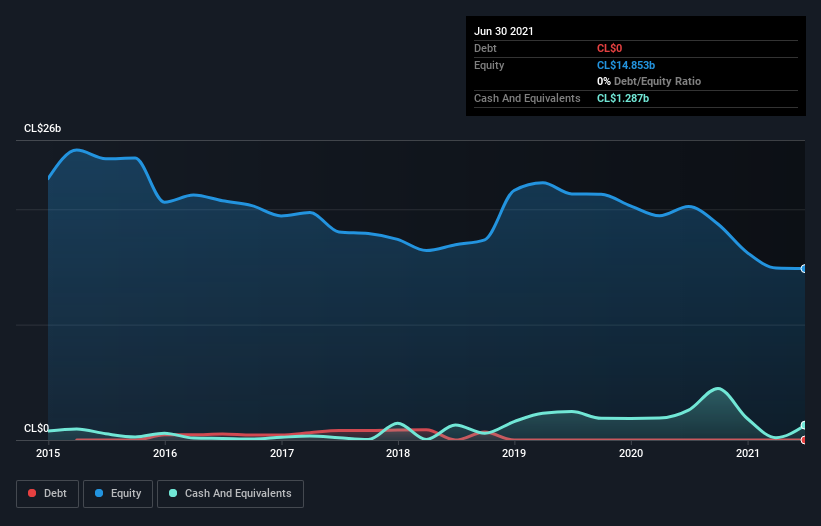- Chile
- /
- Entertainment
- /
- SNSE:COLO COLO
We're Not Very Worried About Blanco y Negro's (SNSE:COLO COLO) Cash Burn Rate

There's no doubt that money can be made by owning shares of unprofitable businesses. For example, biotech and mining exploration companies often lose money for years before finding success with a new treatment or mineral discovery. But while the successes are well known, investors should not ignore the very many unprofitable companies that simply burn through all their cash and collapse.
So, the natural question for Blanco y Negro (SNSE:COLO COLO) shareholders is whether they should be concerned by its rate of cash burn. For the purposes of this article, cash burn is the annual rate at which an unprofitable company spends cash to fund its growth; its negative free cash flow. The first step is to compare its cash burn with its cash reserves, to give us its 'cash runway'.
View our latest analysis for Blanco y Negro
How Long Is Blanco y Negro's Cash Runway?
A company's cash runway is calculated by dividing its cash hoard by its cash burn. When Blanco y Negro last reported its balance sheet in June 2021, it had zero debt and cash worth CL$1.3b. Looking at the last year, the company burnt through CL$902m. That means it had a cash runway of around 17 months as of June 2021. While that cash runway isn't too concerning, sensible holders would be peering into the distance, and considering what happens if the company runs out of cash. Importantly, if we extrapolate recent cash burn trends, the cash runway would be noticeably longer. The image below shows how its cash balance has been changing over the last few years.

Is Blanco y Negro's Revenue Growing?
We're hesitant to extrapolate on the recent trend to assess its cash burn, because Blanco y Negro actually had positive free cash flow last year, so operating revenue growth is probably our best bet to measure, right now. Unfortunately, the last year has been a disappointment, with operating revenue dropping 41% during the period. Of course, we've only taken a quick look at the stock's growth metrics, here. This graph of historic earnings and revenue shows how Blanco y Negro is building its business over time.
Can Blanco y Negro Raise More Cash Easily?
Since its revenue growth is moving in the wrong direction, Blanco y Negro shareholders may wish to think ahead to when the company may need to raise more cash. Companies can raise capital through either debt or equity. One of the main advantages held by publicly listed companies is that they can sell shares to investors to raise cash and fund growth. By looking at a company's cash burn relative to its market capitalisation, we gain insight on how much shareholders would be diluted if the company needed to raise enough cash to cover another year's cash burn.
Blanco y Negro's cash burn of CL$902m is about 5.0% of its CL$18b market capitalisation. That's a low proportion, so we figure the company would be able to raise more cash to fund growth, with a little dilution, or even to simply borrow some money.
So, Should We Worry About Blanco y Negro's Cash Burn?
Even though its falling revenue makes us a little nervous, we are compelled to mention that we thought Blanco y Negro's cash burn relative to its market cap was relatively promising. While we're the kind of investors who are always a bit concerned about the risks involved with cash burning companies, the metrics we have discussed in this article leave us relatively comfortable about Blanco y Negro's situation. On another note, Blanco y Negro has 3 warning signs (and 1 which is potentially serious) we think you should know about.
Of course, you might find a fantastic investment by looking elsewhere. So take a peek at this free list of companies insiders are buying, and this list of stocks growth stocks (according to analyst forecasts)
Valuation is complex, but we're here to simplify it.
Discover if Blanco y Negro might be undervalued or overvalued with our detailed analysis, featuring fair value estimates, potential risks, dividends, insider trades, and its financial condition.
Access Free AnalysisThis article by Simply Wall St is general in nature. We provide commentary based on historical data and analyst forecasts only using an unbiased methodology and our articles are not intended to be financial advice. It does not constitute a recommendation to buy or sell any stock, and does not take account of your objectives, or your financial situation. We aim to bring you long-term focused analysis driven by fundamental data. Note that our analysis may not factor in the latest price-sensitive company announcements or qualitative material. Simply Wall St has no position in any stocks mentioned.
Have feedback on this article? Concerned about the content? Get in touch with us directly. Alternatively, email editorial-team (at) simplywallst.com.
About SNSE:COLO COLO
Blanco y Negro
Focuses on organizing, producing, marketing, and participating in professional entertainment and leisure activities, and shows of sports and recreational.
Low and slightly overvalued.
Market Insights
Community Narratives



